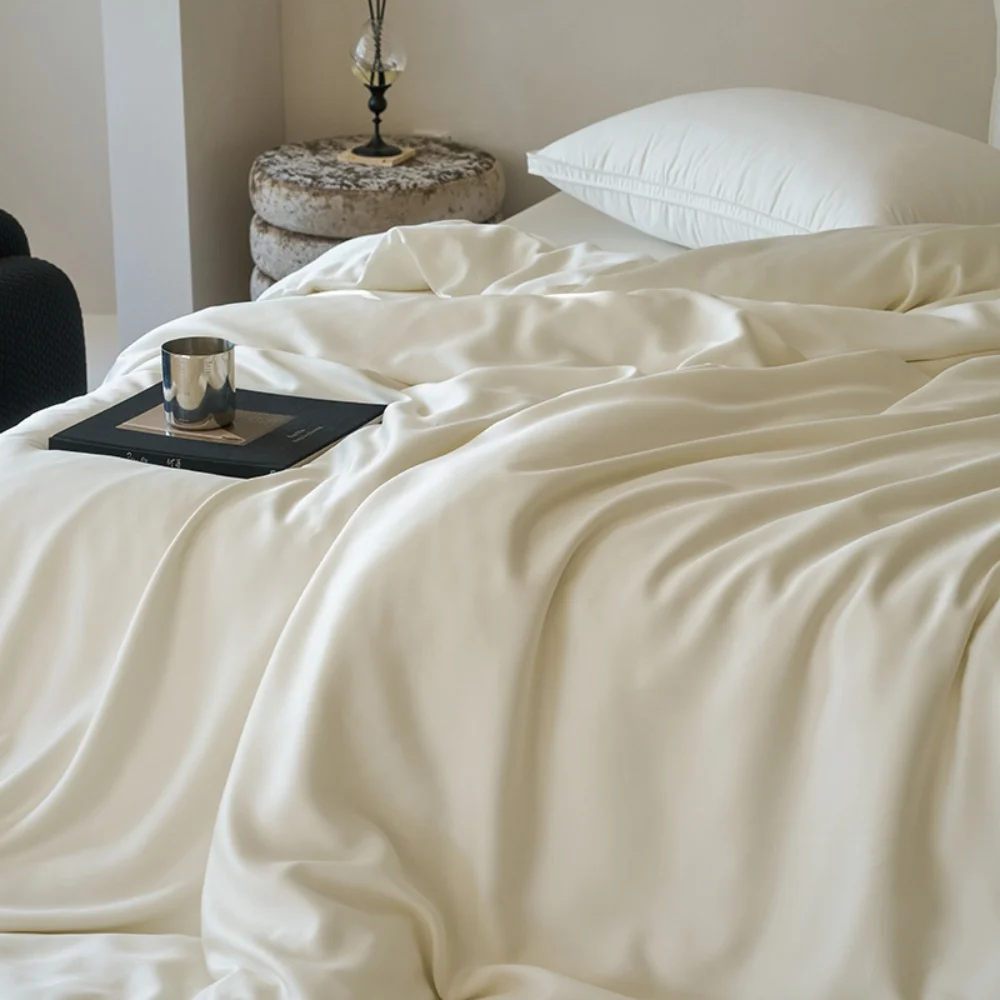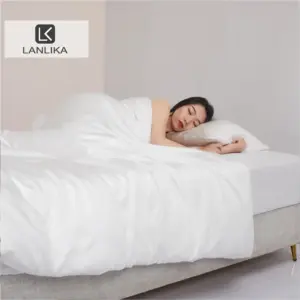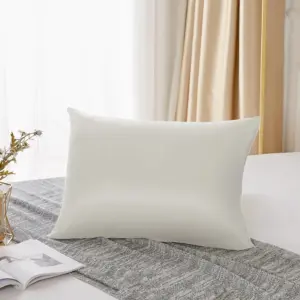Introduction
When we talk about hypoallergenic fabrics, silk stands at the forefront as nature’s premier solution for sensitive skin. But what exactly makes a fabric “hypoallergenic”? In simple terms, hypoallergenic means a material is less likely to trigger allergic reactions compared to other materials. This quality becomes especially important for textiles that come into close contact with our skin for extended periods.
Silk’s reputation as a hypoallergenic material stems from its natural composition and unique physical structure. Unlike many fabrics that can harbor allergens and irritate sensitive skin, silk offers a naturally protective barrier that has benefited humans for over 5,000 years.
The secret behind silk’s exceptional hypoallergenic properties lies in its protein composition. Two key proteins—fibroin and sericin—work together to create a fabric that’s not just luxuriously soft but also naturally resistant to many common allergens. These proteins give silk unique properties that:
- Resist dust mites, one of the most common household allergens
- Repel mold, mildew, and fungal growth
- Discourage bacterial colonization
- Minimize irritation for sensitive skin
With approximately 30% of the global population suffering from allergies of some kind, hypoallergenic fabrics like silk offer significant relief for many individuals. Whether you’re dealing with respiratory allergies, skin sensitivities, or just want a cleaner sleep environment, what makes silk hypoallergenic becomes a crucial consideration.
As we explore deeper in this guide, we’ll discover how silk’s natural properties make it an excellent choice for those with allergies, sensitive skin conditions, and anyone seeking a more comfortable and health-conscious fabric option.
Understanding Silk’s Natural Composition
To fully appreciate silk’s hypoallergenic qualities, we must first understand what makes this remarkable fabric unique at a molecular level. Silk’s composition differs significantly from other natural and synthetic fibers, giving it properties that can’t be easily replicated.
Silk Proteins: The Core of Its Hypoallergenic Nature
The foundation of silk’s hypoallergenic properties lies in its protein structure. Two key proteins dominate silk’s composition:
Fibroin: Making up about 75-80% of silk, fibroin forms the core structural component of silk fibers. This protein features a crystalline structure with tightly packed, aligned molecular chains, giving silk its remarkable strength and elasticity. Fibroin’s molecular structure creates an inhospitable environment for many allergens, as its smooth surface prevents many irritants from adhering.
Sericin: Often called silk’s “glue,” sericin accounts for 20-25% of natural silk. This protein surrounds the fibroin core and contains amino acids that have natural antibacterial and antifungal properties. While some commercial silks have sericin removed during processing (creating what’s known as “degummed” silk), many high-quality hypoallergenic silk products retain controlled amounts for their protective benefits.
This unique protein composition creates a fabric with an amino acid profile that closely resembles human skin. Research has shown that silk contains 18 amino acids that are beneficial to human skin, with some studies suggesting that these proteins can even help skin retain moisture and repair itself.
Unlike proteins in fabrics like wool, which can trigger allergic responses in sensitive individuals, silk’s proteins rarely cause reactions. The science behind silk’s hypoallergenic nature shows that its protein structure provides a natural barrier against many common irritants while remaining gentle on human skin.
Natural Origin and Processing
Silk’s journey from insect cocoon to luxurious fabric involves a process that, when done properly, preserves its natural hypoallergenic qualities. Traditional silk harvesting and processing involves these key steps:
- Silkworms (Bombyx mori) feed exclusively on mulberry leaves
- The worms spin cocoons made of continuous silk filament
- These cocoons are harvested and gently unwound
- Multiple filaments are twisted together to form silk thread
- The threads are woven into fabric
What makes this process special for allergy sufferers is what it doesn’t involve—namely, the harsh chemicals often used in other textile production. The finest mulberry silk bedding sets undergo minimal chemical processing, preserving the natural proteins that give silk its hypoallergenic qualities.
The quality of silk is often measured in momme weight (similar to thread count in cotton), with higher quality silk typically ranging from 19-25 momme. This measurement indicates the density and durability of the silk, with higher momme weights generally providing better allergen resistance and longevity.
Processing methods do matter significantly for maintaining hypoallergenic properties. For example:
- Traditional silk processing retains more natural proteins
- “Peace silk” or “ahimsa silk” production allows the silkworm to emerge before harvesting the cocoon
- Organic silk processing avoids pesticides and chemicals that could cause reactions
- Higher momme weights create denser fabrics that provide better barriers against allergens
By understanding silk’s natural composition and careful processing requirements, we gain insight into why this fabric has stood the test of time as a preferred option for those with sensitive skin and allergies.
How Silk Actively Protects Against Common Allergens
Silk doesn’t just passively avoid causing allergic reactions—it actively fights against many common allergens that plague our homes. This protective quality makes silk especially valuable for allergy sufferers who need relief from symptoms triggered by various household irritants.

The battle against allergens happens at a microscopic level, where silk’s unique structure creates multiple lines of defense. Let’s explore how silk combats some of the most problematic allergens and why hypoallergenic features of silk sheets make them especially beneficial for creating an allergy-friendly sleep environment.
Resistance to Dust Mites
Dust mites are perhaps the most common household allergen, affecting an estimated 20 million Americans. These microscopic creatures feed on skin cells we naturally shed and thrive in warm, humid environments—particularly in bedding. Here’s how silk naturally combats them:
Tight fiber structure: Silk’s dense, tightly woven structure creates a physical barrier that dust mites struggle to penetrate. Unlike cotton’s looser weave, silk’s smooth fibers offer fewer places for mites to establish themselves.
Low moisture retention: Dust mites require humidity levels of 65-80% to thrive. Silk naturally maintains a lower moisture content, creating an inhospitable environment for these allergen-producing creatures.
Smooth surface: Silk’s incredibly smooth fibers provide fewer nooks and crannies for mites to colonize compared to rougher natural fibers like cotton or wool.
Studies comparing dust mite populations in different bedding materials have found significantly lower numbers in silk bedding compared to cotton alternatives. This makes silk bedding particularly beneficial for allergy sufferers who experience nighttime symptoms from dust mite exposure.
Research has shown that switching to silk pillowcases and bedding can reduce dust mite populations by over 70% compared to conventional cotton bedding, making it one of the most effective natural solutions for dust mite allergies.
Inhibition of Mold, Mildew, and Fungi
Mold and mildew thrive in damp environments and can cause significant respiratory issues for allergy sufferers. Silk naturally resists these fungal invaders through several mechanisms:
Efficient moisture management: Silk wicks away moisture rather than absorbing and retaining it, creating conditions unfavorable for fungal growth.
Natural fungicidal properties: The sericin protein in silk contains amino acids that naturally inhibit fungal development, providing an additional layer of protection.
Quick drying properties: Silk dries remarkably quickly compared to other natural fibers, limiting the damp conditions mold needs to establish itself.
Laboratory testing has demonstrated that silk maintains significantly lower fungal counts than cotton under identical environmental conditions. One study found that after 28 days in humid conditions, silk samples showed minimal fungal growth while cotton samples developed substantial colonies.
For individuals with mold allergies or respiratory conditions like asthma that can be triggered by fungal spores, silk provides natural protection against these common household allergens.
Repellence of Bacteria
Bacteria on fabrics can contribute to skin issues, odors, and allergic reactions. Silk naturally inhibits bacterial growth through several mechanisms:
Antimicrobial proteins: The natural proteins in silk, particularly sericin, have been shown in laboratory studies to inhibit the growth of common bacteria like E. coli and Staphylococcus.
Smooth fiber structure: Bacteria have difficulty adhering to silk’s ultrasmooth fibers, making colonization more challenging than on rougher fabrics.
Moisture management: By efficiently wicking away moisture, silk creates a drier environment where bacteria struggle to multiply.
Research has demonstrated that silk maintains lower bacterial counts even after multiple days of use compared to cotton and synthetic alternatives. This makes silk especially beneficial for individuals with compromised skin barriers or those prone to bacterial skin infections.
The hypoallergenic silk fabric benefits extend beyond just avoiding irritation—they actively help maintain healthier skin by reducing exposure to potentially harmful microorganisms.
Reduction of Other Irritants
Beyond the major allergens discussed above, silk also helps minimize exposure to several other common irritants:
Pet dander: The tight weave and smooth surface of silk prevent pet dander from becoming embedded in the fabric, making it easier to remove through regular cleaning.
Pollen: Environmental allergens like pollen have difficulty adhering to silk’s smooth surface compared to fabrics with more textured fibers.
Airborne particulates: Silk creates a more effective barrier against fine particles that can trigger respiratory symptoms.
For individuals with multiple environmental sensitivities, silk’s comprehensive protection against various allergens makes it an excellent choice for bedding, clothing items that contact the skin directly, and other home textiles.
Physical Characteristics That Contribute to Hypoallergenic Qualities
Silk’s hypoallergenic benefits stem directly from its unique physical structure. Understanding these characteristics helps explain why silk performs so differently from other fabrics when it comes to allergy protection.
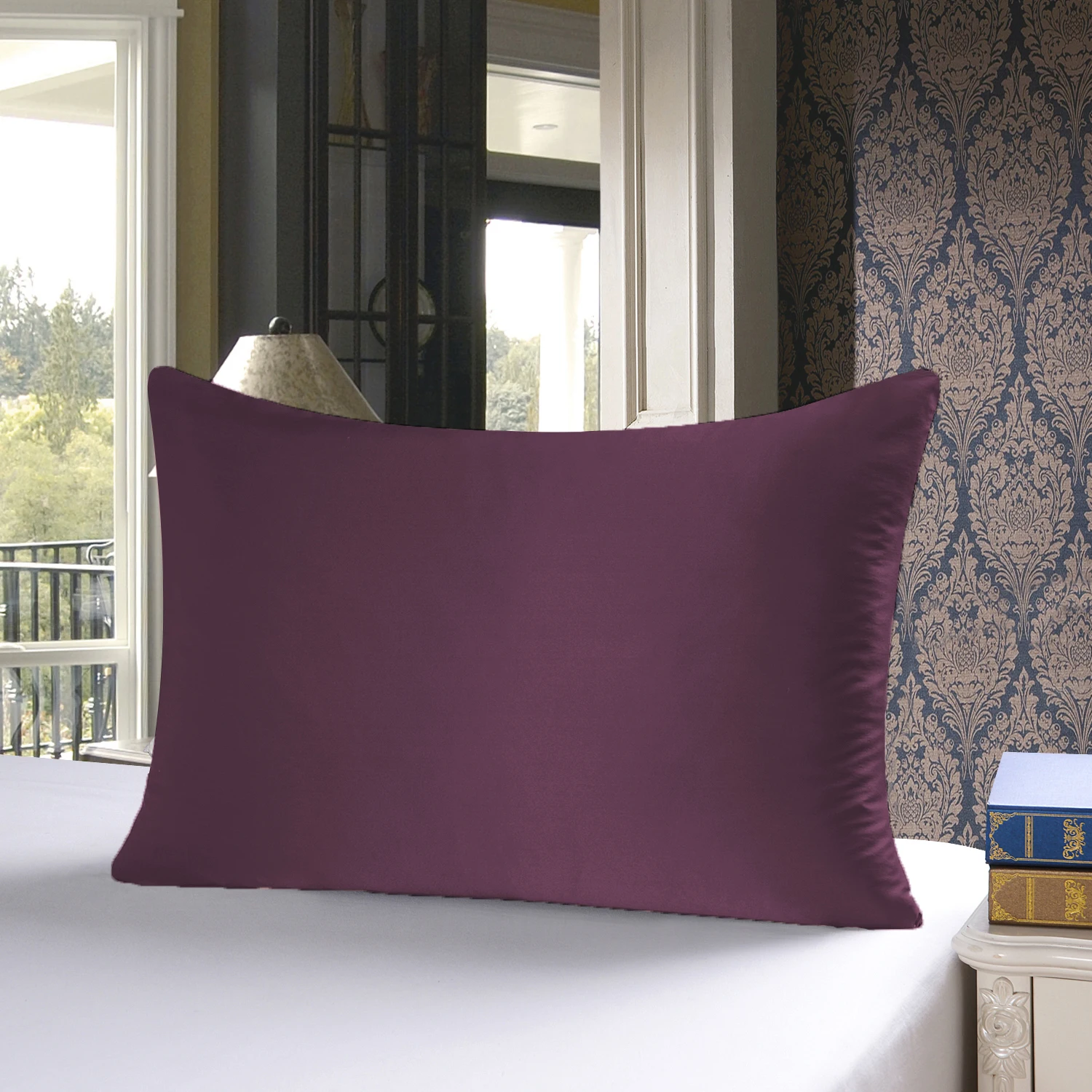
Ultra-Smooth Surface
Perhaps silk’s most distinctive characteristic is its incredible smoothness at the microscopic level. This smoothness creates multiple benefits:
Minimal friction: With a friction coefficient far lower than cotton or synthetic fabrics, silk glides across skin without causing irritation or microdamage. This makes it ideal for sensitive skin conditions where fabric friction can exacerbate symptoms.
Reduced allergen adhesion: Allergens like dust and pollen need textured surfaces to cling to. Silk’s smooth surface makes it difficult for these particles to remain on the fabric, causing them to slide off instead of accumulating.
Decreased skin irritation: The smooth surface means less mechanical irritation of skin cells during contact, which helps preserve skin’s natural barrier function and reduces inflammation.
Under microscopic examination, silk fibers appear as smooth, continuous filaments—unlike cotton’s irregular, rough-edged fibers. This fundamental difference explains why even high-thread-count cotton can’t replicate silk’s gentle interaction with sensitive skin.
The ultra-smooth surface makes silk pillowcases particularly beneficial, as they reduce friction against facial skin and hair during sleep, minimizing irritation and helping preserve skin moisture overnight.
Tightly Woven Structure
Silk’s natural structure and weaving process create a dense fabric with minimal spaces between fibers:
Physical barrier properties: High-quality silk with appropriate momme weight creates a physical barrier that many allergens simply cannot penetrate.
Filtration capability: The tight weave functions somewhat like a natural filter, helping to block particles that might otherwise reach the skin or be inhaled during sleep.
Structural integrity: Silk maintains its protective structure over time, with high-quality 100% silk sheets retaining their barrier properties even after numerous washes when properly cared for.
The optimal momme weight for maximum hypoallergenic benefits typically falls between 19-25 momme. Below this range, the silk may be too thin to provide adequate barrier properties; above it, the fabric becomes unnecessarily heavy without proportional increases in protective qualities.
Exceptional Breathability
Despite its tight weave, silk maintains remarkable breathability—a seeming contradiction that comes from the unique structure of silk fibers:
Microscopic air pockets: Silk fibers contain microscopic air pockets that allow air circulation while maintaining barrier properties.
Temperature regulation: Silk efficiently transfers heat away from the body when it’s warm and provides insulation when it’s cool, helping maintain stable skin temperature.
Prevention of overheating: By allowing proper air circulation, silk helps prevent the excessive warmth and sweating that can exacerbate many skin conditions and create environments favorable to allergens.
Studies measuring air permeability show that silk allows significantly more air transfer than similar-weight synthetic fabrics while still maintaining its protective barrier. This makes cooling silk sheets particularly effective for hot sleepers who also need allergy protection.
Superior Moisture Management
Silk’s interaction with moisture represents another key factor in its hypoallergenic performance:
Efficient wicking: Silk can wick moisture away from the skin while feeling relatively dry to the touch.
Optimal absorption: Silk can absorb up to 30% of its weight in moisture without feeling wet, helping maintain comfortable skin conditions.
Quick evaporation: Once absorbed, moisture evaporates quickly from silk, preventing the damp conditions that allow allergens to thrive.
Stable moisture content: Silk maintains a moisture content of roughly 11% under normal conditions—enough to prevent static electricity but not enough to support allergen growth.
This exceptional moisture management creates an environment that’s comfortable for skin but inhospitable for common allergens that require higher humidity levels to survive and reproduce.
Therapeutic Benefits for Sensitive Skin and Allergic Conditions
Beyond preventing allergic reactions, silk offers therapeutic benefits for various skin conditions and allergies. Its unique properties make it an effective part of managing several common health concerns.

Alleviating Eczema and Psoriasis Symptoms
For the millions who suffer from eczema (atopic dermatitis) and psoriasis, silk can provide significant relief:
Friction reduction: Silk’s smooth surface minimizes the mechanical irritation that can trigger flare-ups in sensitive skin conditions.
Temperature regulation: Stable skin temperature helps reduce the itch-scratch cycle that exacerbates eczema symptoms.
Medication preservation: Unlike cotton, which can absorb topical medications, silk allows creams and ointments to remain on the skin where they belong.
Natural moisture balance: Silk helps maintain skin’s optimal moisture levels without creating excessive dryness or humidity.
Dermatologists increasingly recommend silk for eczema patients, particularly for bedding. A clinical study published in the British Journal of Dermatology found that children with eczema who used silk bedding showed significant improvement in symptoms and required less topical medication compared to those using cotton bedding.
For practical application, many dermatologists suggest starting with silk pillowcases, then expanding to full bedding sets as improvement is observed.
Reducing Acne Breakouts
Acne sufferers can also benefit from silk’s unique properties:
Non-comedogenic nature: Silk doesn’t clog pores, allowing skin to breathe properly during sleep.
Bacterial resistance: As previously discussed, silk naturally resists bacterial growth—important since bacteria contribute to acne inflammation.
Reduced irritation: Less friction means less irritation to existing blemishes, potentially reducing inflammation and scarring.
Clean surface: Silk’s resistance to oil and debris accumulation means a cleaner surface against facial skin overnight.
Standard size silk pillowcases have become particularly popular for acne management, with many users reporting noticeable improvements within weeks of switching from cotton. This simple change provides maximum face-to-fabric contact with minimal investment.
General Skin Sensitivity
For those with generally sensitive skin or multiple chemical sensitivities, silk offers comprehensive benefits:
Chemical-free option: High-quality silk processed without harsh chemicals provides a truly hypoallergenic fabric option.
Anti-aging benefits: The reduced friction helps prevent sleep wrinkles and creases that can become permanent over time.
Hydration maintenance: Silk helps skin retain its natural moisture, preventing the dryness that often triggers sensitivity reactions.
Natural pH alignment: Silk’s natural pH is close to that of human skin, making it less likely to disrupt skin’s acid mantle.
Many individuals who cannot tolerate other fabrics find that silk causes no irritation, making it an excellent option for those with multiple fabric sensitivities or conditions like fibromyalgia where tactile comfort is particularly important.
Benefits for Asthma and Rhinitis Sufferers
Respiratory allergy sufferers gain significant benefits from silk bedding:
Reduced allergen exposure: By minimizing dust mites, mold, and other common triggers, silk bedding can help reduce nighttime asthma symptoms and morning congestion.
Improved sleep quality: Better breathing leads to improved sleep, creating a positive cycle that enhances overall health.
Fewer nighttime symptoms: Many users report fewer nighttime awakenings due to respiratory symptoms when using silk bedding.
Long-term benefits: Creating an allergen-minimized sleep environment with luxury silk bedding sets can reduce overall allergen exposure and potentially decrease medication needs over time.
A study published in the Annals of Allergy, Asthma & Immunology found that participants using silk bedding showed reduced nighttime respiratory symptoms and improved sleep quality compared to those using conventional bedding materials.
Silk vs. Other Fabrics: A Hypoallergenic Comparison
To truly understand silk’s value for allergy sufferers, it helps to compare it with other common fabric options. Each material has distinct properties that affect its suitability for sensitive individuals.
Cotton
Cotton remains the world’s most popular fabric, but its hypoallergenic properties differ significantly from silk:
Allergen retention: Cotton’s absorbent, textured fibers easily trap dust mites, pollen, and other allergens. Studies show cotton can harbor up to 2,000 times more allergens than silk under identical conditions.
Moisture absorption: Cotton absorbs and retains moisture at much higher levels than silk, creating potential breeding grounds for dust mites and fungi. Cotton can hold up to 27% of its weight in moisture before feeling damp.
Chemical concerns: Conventional cotton is one of the most heavily sprayed crops globally, potentially exposing sensitive individuals to pesticide residues unless organic options are chosen.
Benefits: Cotton is breathable, washable at high temperatures, and generally more affordable than silk.
While organic cotton represents an improvement over conventional options, it still can’t match silk’s natural hypoallergenic properties. Cotton-silk blends offer a middle ground but sacrifice some of silk’s protective qualities.
Synthetic Fabrics (Polyester, Nylon)
Synthetic fabrics offer different advantages and disadvantages for allergy sufferers:
Chemical composition: Synthetics are manufactured using various chemicals that may cause sensitivity reactions in some individuals. Off-gassing can continue for the life of the product.
Static electricity: Synthetic fabrics generate more static electricity than natural fibers, attracting airborne allergens like dust and pollen.
Breathability limitations: Most synthetics offer poor breathability compared to silk, potentially creating overheating and excess sweat that can irritate sensitive skin.
Bacteria resistance: Some modern synthetics incorporate antibacterial treatments, though these often involve additional chemicals that may cause reactions.
While innovations like microfiber claim hypoallergenic benefits, they cannot match silk’s natural properties without chemical additives that may themselves cause sensitivity reactions.
Wool and Down
These natural materials offer warmth but present challenges for many allergy sufferers:
Protein allergens: Wool contains lanolin and other proteins that commonly trigger allergic reactions. An estimated 3-4% of the population has some sensitivity to wool proteins.
Dust mite haven: Down’s structure creates numerous spaces where dust mites can thrive, even after cleaning. One study found that down pillows contained 4-8 times more dust mite allergens than synthetic alternatives.
Cleaning challenges: Both wool and down present cleaning challenges that can allow allergens to accumulate over time.
Temperature regulation: Both materials offer excellent thermal regulation benefits similar to silk, but with significantly higher allergen risks.
While high-quality wool and down products remain popular for their warmth and natural origins, they represent poor choices for many allergy sufferers compared to silk alternatives.
Linen
Another natural fiber with different hypoallergenic properties:
Texture considerations: Linen’s relatively rough texture can irritate sensitive skin through mechanical friction, unlike silk’s smooth surface.
Allergen trapping: While less absorbent than cotton, linen’s visible weave structure still provides more places for allergens to hide compared to silk.
Natural origins: Like silk, linen is derived from natural sources (flax plants) and typically involves fewer chemicals in processing than synthetics.
Breathability: Linen offers excellent breathability comparable to silk, making it a good option for those without texture sensitivities.
Linen represents a better hypoallergenic choice than cotton or synthetics for many individuals, but still falls short of silk’s comprehensive benefits for those with significant allergies or sensitivities.
Trust and Purity: Certifications for Silk Products
When investing in silk for its hypoallergenic benefits, certifications help ensure you’re getting a pure product that lives up to its promises. These third-party verifications test for harmful substances and validate processing standards.
OEKO-TEX® Standard 100 Certification
The most recognized global standard for textile safety, OEKO-TEX® certification provides crucial assurance for allergy sufferers:
Comprehensive testing: Products are tested for over 100 harmful substances, including pesticides, heavy metals, formaldehyde, and other chemicals that could trigger reactions.
Four product classes: The certification includes different standards based on skin contact, with Class I being the most stringent for items that contact sensitive skin (like bedding).
Regular verification: Certified products undergo annual re-testing to maintain their certification status.
Label verification: Authentic certification includes a unique verification code that consumers can check on the OEKO-TEX® website.
When shopping for silk products, look for the OEKO-TEX® label—particularly the Standard 100 certification—as it indicates the product has been tested specifically for substances that could trigger allergic reactions or skin sensitivities.
Other valuable certifications for silk products include:
- Global Organic Textile Standard (GOTS): For organic silk processed without harmful chemicals
- STANDARD 100 by OEKO-TEX®: Ensures the entire product, including threads and accessories, meets strict safety standards
- bluesign®: Focuses on environmentally safe production without harmful substances
These certifications help consumers identify truly hypoallergenic silk products among the many options available in today’s market.
Practical Applications of Hypoallergenic Silk in Everyday Life
Knowing silk’s hypoallergenic benefits is one thing—putting this knowledge into practice is another. Here are practical ways to incorporate silk into daily life for maximum allergy and sensitivity benefits.

Bedding for Allergy Sufferers
The bedroom offers the most significant opportunity for allergy relief with silk products:
Pillowcases: Often the first silk item people try, pillowcases provide direct facial skin contact and create an immediate barrier against dust mites in pillow fill. Look for options with hidden zippers that fully encase the pillow.
Sheets: Full silk sheets extend benefits to the entire body and create a comprehensive barrier between you and mattress allergens. Optimal momme weight for sheets is 19-22 momme for durability with maximum softness.
Duvet covers: Protect down or synthetic comforters with silk duvet covers to reduce allergen exposure without sacrificing warmth.
Comprehensive approach: For maximum benefit, queen size silk bedding sets create a complete hypoallergenic sleep environment.
Mattress and pillow protectors: Combine silk bedding with allergen-impermeable mattress and pillow protectors for a comprehensive approach to bedroom allergen reduction.
Research shows that creating a comprehensive allergen-minimized sleep environment can reduce nighttime allergy symptoms by up to 60% without medication.
100% Silk Sheets, Green Silk Sheets, King Size Silk Bedding Set, Mulberry Silk Bedding Sets, Queen Size Silk Bedding Set
Price range: $1,246.21 through $1,615.22 Select options This product has multiple variants. The options may be chosen on the product pageGrey Silk Sheets, Silk Sheet and Pillowcase Set
Price range: $88.20 through $146.64 Select options This product has multiple variants. The options may be chosen on the product pageBamboo Silk Sheets, Cooling Silk Sheets
Price range: $130.76 through $177.80 Select options This product has multiple variants. The options may be chosen on the product page100% Silk Sheets, King Size Silk Bedding Set, Mulberry Silk Bedding Sets, Queen Size Silk Bedding Set, White Silk Sheets
Price range: $1,000.79 through $1,351.42 Select options This product has multiple variants. The options may be chosen on the product pageKing Size Silk Pillowcases, Mulberry Silk Pillowcases, Queen Size Silk Pillowcases
Price range: $94.96 through $121.56 Select options This product has multiple variants. The options may be chosen on the product pageMulberry Silk Fitted Sheet, Mulberry Silk Sheets
Price range: $486.21 through $944.97 Select options This product has multiple variants. The options may be chosen on the product page
Apparel for Sensitive Skin
Silk clothing offers significant benefits for those with skin sensitivities:
Base layers: Silk undergarments provide a protective layer between sensitive skin and potentially irritating outer clothing.
Sleepwear: Pajamas and nightgowns made from silk maximize skin contact during sleep, helping with nighttime skin recovery.
Scarves and wraps: These versatile accessories protect the neck and chest area from irritating clothing like wool sweaters while adding elegant style.
Seasonal options: Silk’s natural temperature regulation makes it suitable year-round—cooling in summer and insulating in winter.
For those with extensive skin sensitivities, gradually replacing key wardrobe items with silk alternatives can provide cumulative benefits for skin health.
Hair and Skin Accessories
Small silk accessories offer affordable entry points to experience silk’s benefits:
Scrunchies and hair ties: Silk versions reduce hair breakage and prevent the pressure marks that can irritate sensitive scalps.
Sleep masks: Silk eye masks reduce friction around the delicate eye area while blocking light for better sleep.
Headbands and bonnets: Protect hair and skin while keeping hair oils away from facial skin that might be prone to breakouts.
Pillowcase liners: For travel, silk travel pillowcases can be placed over hotel pillows to maintain hypoallergenic benefits away from home.
Sanctuary Soft’s silk accessories feature the same high-quality, hypoallergenic silk as our bedding, ensuring consistent benefits across all products.
Maintaining Silk’s Hypoallergenic Qualities Through Proper Care
To preserve silk’s hypoallergenic benefits, proper care is essential. The right maintenance keeps silk performing at its best while extending its lifespan.
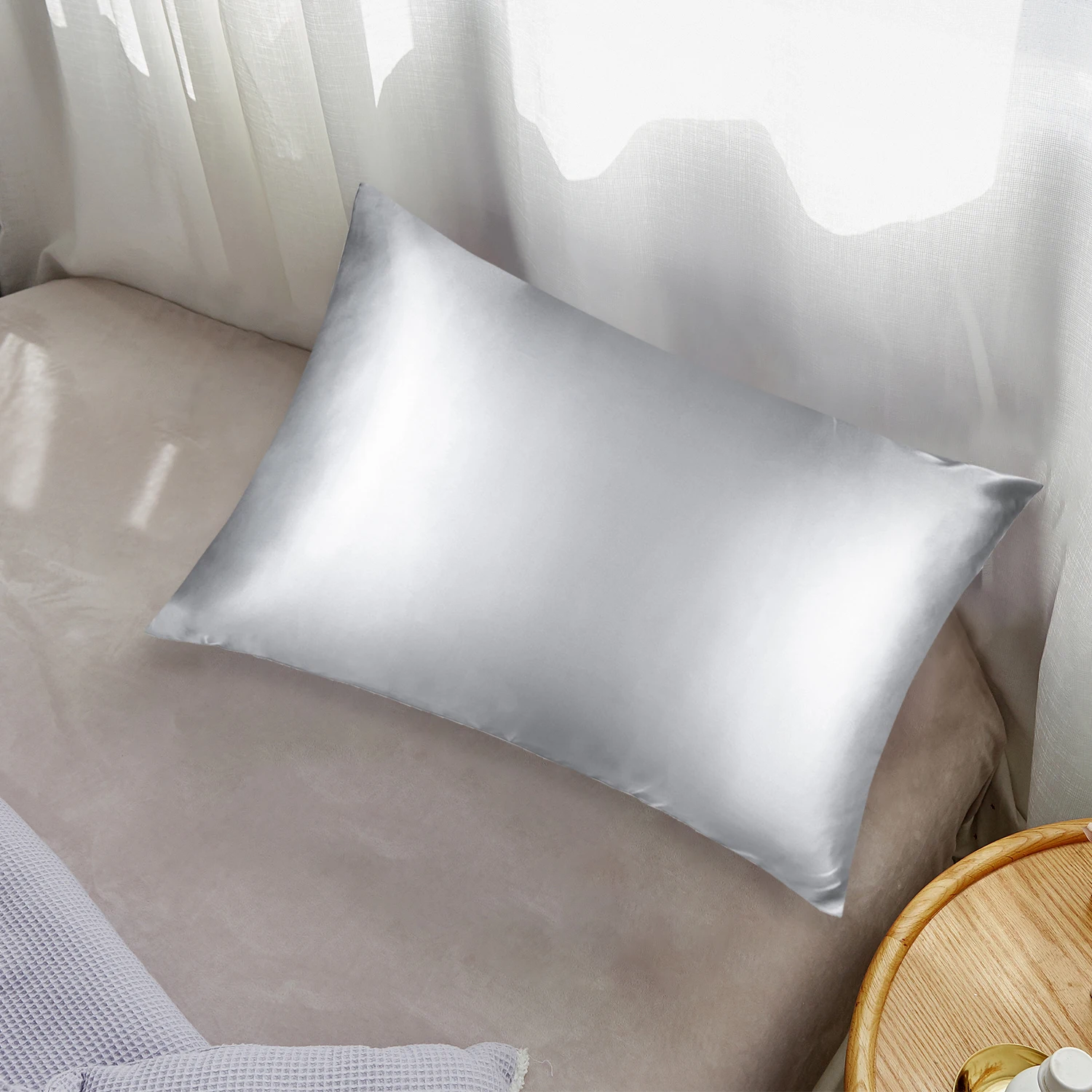
Follow these guidelines to maintain silk’s protective qualities:
Gentle washing: Hand wash or use a washing machine’s delicate cycle with cold water. Always use pH-neutral detergents specifically formulated for silk.
Avoid harsh chemicals: Never use bleach, fabric softeners, or enzyme-containing detergents, as these break down silk’s natural proteins.
Proper drying: Air dry silk away from direct sunlight, which can damage fibers and proteins. Never use a dryer.
Avoid excessive heat: Keep silk away from radiators, heaters, and hot water, as heat can damage its protein structure.
Limited ironing: If necessary, iron silk on the lowest setting while still slightly damp, using a pressing cloth between the iron and silk.
Storage considerations: Store silk in breathable bags or containers away from direct sunlight. Cedar blocks provide natural protection against moths without chemicals.
Regular cleaning: Wash silk bedding every 1-2 weeks to remove accumulated skin cells, oils, and environmental allergens before they build up.
Rotation system: Having multiple sets of silk bedding allows proper rotation and adequate drying time between uses.
Following these care guidelines ensures that silk maintains its hypoallergenic properties for years, making it a worthwhile investment for allergy sufferers.
Is All Silk Truly Hypoallergenic?
While silk is naturally hypoallergenic, not all silk products offer equal benefits. Understanding these variations helps consumers make informed choices.
Different silk varieties offer varying hypoallergenic properties:
Mulberry silk: The highest quality and most hypoallergenic option, produced by Bombyx mori silkworms fed exclusively on mulberry leaves. Its consistent fiber structure creates the smoothest, most regular silk.
Tussah silk (wild silk): Produced by wild silkworms with a diet of oak and juniper leaves, resulting in stronger but coarser fibers with slightly reduced hypoallergenic benefits.
Eri silk: Another wild variety with good hypoallergenic properties but less consistent fiber quality than mulberry silk.
Processed variations: “Washed silk” and other heavily processed versions may have reduced hypoallergenic benefits due to protein structure changes during processing.
Processing methods significantly impact hypoallergenic qualities:
Chemical treatments: Harsh bleaches, dyes, or finishes can introduce irritants that counteract silk’s natural benefits.
Degumming processes: Excessive sericin removal can diminish silk’s natural antibacterial properties.
Blended fabrics: Silk blended with synthetic fibers or cotton loses some of its hypoallergenic advantages.
While true silk allergies are extremely rare (affecting less than 0.1% of the population), they can occur. Symptoms typically appear as contact dermatitis where the skin touches the fabric. Individuals with rare protein sensitivities should test silk against a small area of skin before investing in larger items.
To identify truly hypoallergenic silk products, look for:
- Certification labels like OEKO-TEX®
- 100% mulberry silk labeling
- Appropriate momme weight for the product type
- Natural or gentle dyeing processes
- Reputable manufacturers with transparent production methods
Common Myths About Silk’s Hypoallergenic Properties
Despite silk’s legitimate hypoallergenic benefits, several misconceptions exist about this remarkable fabric:
Myth 1: All silk is equally hypoallergenic
Truth: Significant variations exist based on silk type, processing methods, and silk quality factors like momme weight. Pure, minimally processed mulberry silk offers the greatest hypoallergenic benefits.
Myth 2: Silk is completely allergen-proof
Truth: While highly resistant, silk still requires regular cleaning to prevent allergen buildup. No fabric creates an absolute barrier against all potential allergens.
Myth 3: Silk benefits come only from its smooth texture
Truth: While texture is important, silk’s hypoallergenic benefits derive from multiple factors including protein structure, moisture management, and natural antimicrobial properties.
Myth 4: Silk is too delicate for regular use
Truth: High-quality silk with appropriate momme weight is surprisingly durable when properly cared for. Many silk sheets last 10+ years with proper maintenance.
Myth 5: Synthetic “silk alternatives” offer the same benefits
Truth: While synthetic alternatives may mimic silk’s appearance and feel, they cannot replicate the natural protein structure that provides silk’s comprehensive hypoallergenic benefits.
Myth 6: Silk’s hypoallergenic benefits are just marketing hype
Truth: Scientific research consistently confirms silk’s natural resistance to dust mites, mold, and bacteria, along with its benefits for sensitive skin conditions.
Understanding these misconceptions helps consumers make informed decisions about incorporating silk into their allergy management strategies.
Frequently Asked Questions (FAQs)
How often should I wash silk items to maintain hypoallergenic properties?
For bedding, washing every 1-2 weeks is optimal. Clothing should be washed after 2-3 wears, depending on use and season. Regular cleaning prevents allergen accumulation while proper washing techniques preserve silk’s beneficial properties.
Can I be allergic to silk itself?
True silk allergies are extremely rare, affecting less than 0.1% of the population. Most reactions attributed to “silk allergies” actually stem from dyes, processing chemicals, or residual detergents rather than the silk protein itself.
Is silk suitable for babies with sensitive skin?
Yes, pure silk without harsh dyes is excellent for babies with sensitive skin or conditions like eczema. Start with a silk pillowcase and monitor for any reactions before investing in additional items.
Does the momme weight of silk affect its hypoallergenic properties?
Yes. Higher momme weights (19-25) generally provide better allergen barriers and durability. For maximum hypoallergenic benefits in bedding, look for 22-25 momme weight, which offers optimal density while maintaining breathability.
How can I tell if silk products are 100% pure silk?
Pure silk has a distinctive smooth, cool feel and natural sheen rather than artificial shininess. The burn test (silk burns slowly with an ash you can crush) works but damages the item. Look for reputable retailers, certification labels, and appropriate pricing—quality silk sheet and pillowcase sets represent an investment due to the material’s natural value.
Can silk help with hot flashes and night sweats?
Yes. Silk’s exceptional temperature regulation and moisture management properties make it particularly beneficial for those experiencing hot flashes or night sweats, helping maintain comfort without creating dampness that could harbor allergens.
How does silk compare to bamboo fabric for hypoallergenic properties?
While bamboo offers some natural antimicrobial properties, most bamboo fabric undergoes extensive chemical processing that reduces these benefits. Silk maintains superior hypoallergenic properties with less processing and offers better moisture management for allergy sufferers.
Is peace silk/ahimsa silk as hypoallergenic as traditional silk?
Yes. Peace silk (which allows the silkworm to emerge before harvesting) maintains similar hypoallergenic properties to traditional silk. The main difference lies in fiber length and potential irregularities in texture, not in the hypoallergenic qualities.

